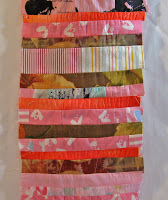Remember...there is still time to sign-up for a summer Beginning Machine Sewing Class. Just go to the Blog entry for more info
Instructions
The following instructions will teach you how to sew a neat, almost invisible, Hem every time.Things You'll Need
Dressmaker Pins
Fabric-marking Pens or Fabric Chalk
Ironing Board and Iron
Sewing Needle
Thread
Scissors
Prepare Hemline Area
- If garment already has a hem, use a seam ripper to rip out the hem. Take care not to rip any fabric when you take out the thread.
- Iron flat that area of the fabric you need to hem and/or previous hem crease lines
Determine Hem Length
1. Put on the garment and stand in front of a mirror to determine appropriate length.
2. Use a fabric marking pen, tailor's chalk or straight pins to mark the desired hemline. Allow for a hem at least 5/8” in length
3. Make skirt/pants hems no deeper than 1 ½ to 2 inches. Any deeper and the edge of the skirt will look too bulky and will not lie right. Trim any excess fabric.
Turn Up Garment to Desired Hemline
1. Turn garment wrong side out. On a flat surface such as a table or a hardcover book on your lap, turn up hem. Pin hem into place and iron hemline
2. Once hem is pinned, check to make sure hem is evenly distributed, with no bulky sections or gathers. If there are, just re-pin that section until it is more even. I usually try garment one more time to ensure hemline is correct length and even all around
Choose best thread and needle for fabric
The right thread is the most critical thing to ensure that your hem is almost invisible.
THREAD TYPES:
a. Light, filmy, or delicate fabric (such as chiffon, satin, jersey, cheesecloth, etc) use a very light nylon thread.
b. Medium weight (such as cotton, linen, polyester, etc) use a regular nylon thread.
c. Thick, heavy or bulky (such as denim, canvas, polar fleece, etc) consider using a heavier cotton thread.
THREAD COLOR
a. Try to get a matching color of your fabric
b. If matching color is not possible go go for a slightly lighter color than your fabric rather than darker, as this is less likely to show.
HAND-SEWING NEEDLE
a. Light filmy fabrics use a very fine needle,
b. Meduim weight fabrics use a regular sized needle
c. Heavier fabrics use a larger more robust needle
d. To see whether you have the right needle, run it through your material once without any thread in it. If the hole you create with the needle closes up or disappears by itself, you've got the right needle. If you can see the hole afterwards, try a smaller needle.
Sew Hem
1. Machine or hand stitch the hem into place.
2. Hand-sew hem
a. Thread your needle, and leave the short end of thread about 20cm long or 8". (I never sew with the thread doubled unless I am sewing on a button) Tie a knot in the long end of the thread.
b. I find it easiest to sew with the garment or the part to be sewn on my lap
c. How far apart you sew the stitches depends on how robust the hem needs to be (the more wear and tear, the closer the stitches need to be), the weight of the fabric (generally lighter fabrics can have stitches farther apart than heavier fabrics) and whereabouts on the garment the hem is (if fingers or toes are likely to get caught in the hem when putting it on, the stitches should be closer together).
d. To finish off the hem, sew 2 stitches one on top of the other.
Instructions are written from my own sewing experiences and the following sources:
How to Sew a Hem By Diane Ellis, owner ofwww.Sewing4Dummies.com.












